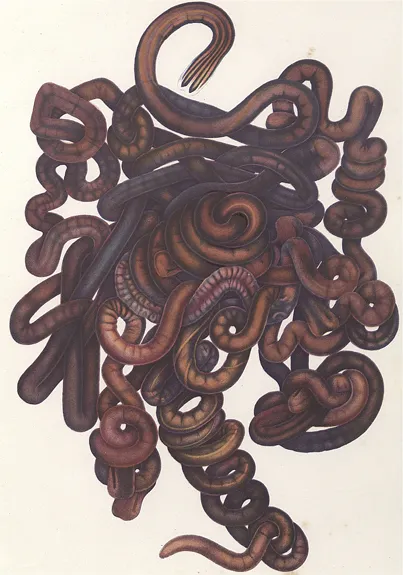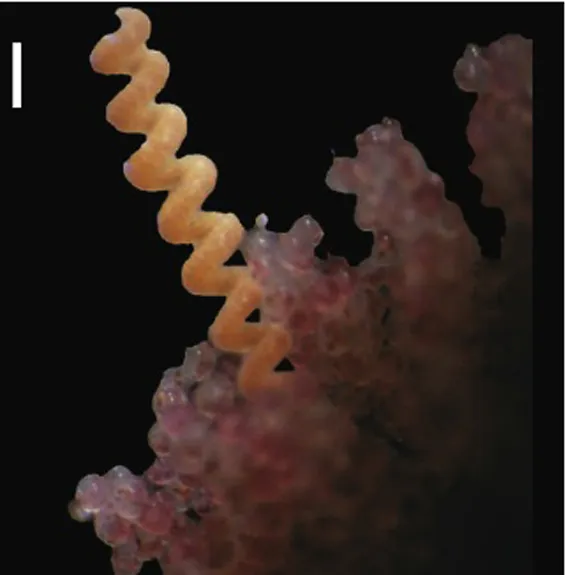14 Fun Facts about Marine Ribbon Worms
Ribbon worms swallow prey whole, grease themselves with their mucus to slide quickly through mud, split into new worms if severed, and much more
/https://tf-cmsv2-smithsonianmag-media.s3.amazonaws.com/filer/20130315013213Nemertea_Basiodiscus_mexicanus-470px.jpg)
Whether they’re on a rain-soaked sidewalk, in the compost bin or on the end of a fish hook, the worms most people know are of the segmented variety. But what about all the other worms out there?
With more than 1,000 species of ribbon worms (phylum Nemertea), most found in the ocean, there is a huge range of sizes and lifestyles among the various types. A defining characteristic of ribbon worms is the presence of a proboscis—a unique muscular structure inside the worm’s body. When attacking prey, they compress their bodies to push out the proboscis like the finger of a latex glove turned inside-out.
Here are 14 other fun facts about them:
1. The largest species of ribbon worm is the bootlace worm, Lineus longissimus, which can be found writhing among rocks in the waters of the North Sea. Not only is it the largest nemertean, but it may also be the longest animal on the planet! Uncertainty remains because these stretchy worms are difficult to accurately measure, but they have been found at lengths of over 30 meters (98 feet) and are believed to even grow as long as 60 meters (197 feet)—longer than the blue whale! Despite their length they are less than an inch around.

2. The smallest ribbon worm species is less than a centimeter long, and resembles a piece of thread more closely than what we think of as a worm.
3. Ribbon worms have highly developed muscles that allow them to contract their bodies, shrinking to a tenth of their extended length when threatened.
4. Talk about stretching: ribbon worm muscles don’t just contract–they can also expand, allowing some species to swallow prey (such as other kinds of worms, fish, crustaceans, snails and clams) that are more than double the width of their narrow bodies
Ribbon worm (Nemertean) eating a polychaete annelid from LabNemertea on Vimeo.
5. The proboscis varies among the species. Some are sticky or have suckers to help grasp prey, and some species, like those in the order Hoplonemertea, even stab their prey with a sharp spike, called a stylet, on the proboscis.
6. Because the stylets often are lost during an attack, the worms continually make and use replacements that they have in reserve in internal pouches.
7. As a second line of defense, many ribbon worms are poisonous and taste bad. Several species contain tetrodotoxin, the infamous pufferfish venom that can induce paralysis and death by asphyxia. It’s still not known exactly how the toxins are produced—they may linger in the worms from ingested bacteria—but they deter predators from taking a bite. Some even eject toxins from their proboscis.
8. Some ribbon worms sneak up on their prey, lying in wait buried in the sandy seafloor. One species of worm will pop up from its home in the sand when a fiddler crab walks over. The worm will cover the prey with toxic slime from its proboscis, paralyzing the crab so the ribbon worm can slide into a crack in the shell and eat the crab from the inside out.
9. Not all ribbon worms are predators – some are parasites. One genus of ribbon worms, Carcinonemertes, lives as a parasite on crabs, eating the crab’s eggs and any animals that it can find from the confines of its host.

10. Most ribbon worms produce a slippery mucus that covers their bodies and helps them to navigate through the mud and rocks on the ocean floor.
11. Some also use the mucus as a protective coat to keep from drying out when exposed to air during low tides. Others use their proboscis to move by attaching it to an object and pulling themselves forward. This same mucus makes them hard to catch! And not only by predators: scientists trying to catch the worms have a difficult time.
12. Marine ribbon worms usually have separate sexes and temporary sex organs. Rows of gonads line the inside of their bodies to produce either eggs or sperm. When they are ready to be released, the gonad ducts form on demand and are reabsorbed after reproduction.
13. Most ribbon worms have direct development: a miniature version of the worm hatches from a fertilized egg. However, the young of one group of ribbon worms, the heteronemerteans, emerge in a bizarre larval stage that looks like a flying saucer. After a few weeks to months living and feeding in the open ocean, a small worm develops inside and, when it’s ready, it eats its way out of the original larva encasing. Then the worm falls to the sea floor where it spends the rest of its life.
14. Many ribbon worms can regenerate when a predator takes a bite, healing their broken ends. One worm species, Ramphogordius sanguineus, has an exceptional ability to regenerate: if any part of their body is severed (except for the very tip of their tail where there are no nerves), it can regrow into a new worm. This new individual may be smaller than the worm it came from, but more than 200,000 worms can result from an individual that is only 15 centimeters (6 inches) long!
Learn more about the ocean from the Smithsonian’s Ocean Portal.